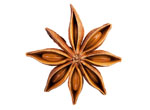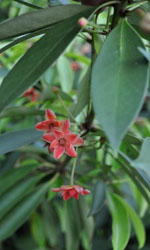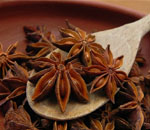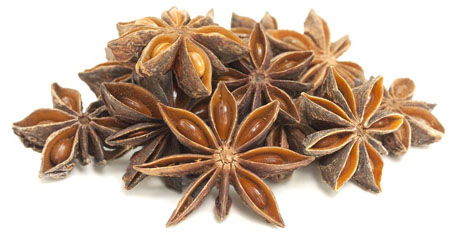What Is Star Anise?

This star-shaped spice is the dried fruit of a small evergreen tree (a member of the magnolia family) known scientifically as Illicium verum. Harvested when it's still green and unripe, it's dried in the sun, where it develops its red-brown color and a sweet warm flavor that's reminiscent of licorice, clove, fennel seed, and aniseed (although it's botanically unrelated to any of these spices).
Star Anise Plant and Cultivation

Star anise is native to China and grows in warm subtropical climate. Star anise is grown in four provinces in China and harvested between March and May. It is a frost tender perennial. Star anise only grows in areas where the temperature does not fall below 15 F (-10 C). In a cooler area below USDA Zone 9, star anise should be plant in a container so that you can keep it in a greenhouse or indoors in winter. Star anise requires dappled shade, partial sun if it’s growing star anise in a much cooler climate, plant it in a warm and sunny location. Choose location in a way that it is not exposed to cold and dry winds. Soil should be humus and compost rich. Soil texture should be loamy and well drained. Slightly acidic to neutral soil is optimal. For growing star anise, it requires regular watering and the soil should be kept slightly moist but reduce the watering in winter.
Star Anise Description

Star anise is the unusual fruit of a small oriental tree. It is, as the name suggests, star shaped, radiating between five and ten pointed boat-shaped sections, about eight on average. These hard sections are seed pods. Tough skinned and rust coloured, they measure up to 3cm (1-1/4”) long. The fruit is picked before it can ripen, and dried. The stars are available whole, or ground to a red-brown powder.
Uses of Star Anise

Star anise oil is a highly fragrant oil used in cooking, perfumery, soaps, toothpastes, mouthwashes, and skin creams. About 90% of the world's star anise crop is used for extraction of shikimic acid, a chemical intermediate used in the synthesis of oseltamivir.
10 Health Benefits of Star Anise
1 - Antifungal Properties - Extracts from the star anise plant, Illicium verum, showed significant promise as a natural anti-fungal.
2 - Cure Rheumatism - The oil of star anise has been found to be beneficial in patients with rheumatism and also with lower back pain. Regular massage with the oil containing star anise helps.
3 - Heart Health - Star anise maintains blood pressure level. It cuts down on the pressure on the heart. Additionally, it enhances blood flow as well as keeps the heart healthy and balanced.
4 - Skin Disease - Star anise is also quite helpful of pain relief brought on by rheumatism and, it is also useful to treat skin diseases.
5 - Great digestive aid - Star anise is known to help reduce bloating and gas, aid digestion as well as treat indigestion and associated abdominal pain (it is also a mild sedative). Drinking star anise tea, flavoring soups and other dishes with the ground spice or cooking several seed pods together with the other ingredients in a recipe is believed to have an overall beneficial action on one’s digestion.
6 - Antioxidant & Anti-inflammatory - Star anise is rich in polyphenolic compounds and chemical constituents with various health effects. Flavonoids such as kaempferol, quercetin as well as phenolic compounds such as caffeic acid, p-coumaric acid, etc. have been shown to have antioxidant properties and inhibit carcinogenesis.
7 - Helps in sleep Disorders - Star anise has a sedative property and may be helpful for people with sleep disorders.
8 - For Influenza - Star anise is the best natural source of Shikimic acid which is used in the anti-flu medication Tamiflu. Shikimic acid is rare in nature-it is present in sweetgum fruit and ginkgo but occurs in far greater concentrations in star anise.
9 - Coughs - Star anise tea is an excellent natural remedy to ease a cough and soothe your sore throat.
10 - Antiseptic - Star Anise also has antiseptic properties and give wounds an effective protective layer against infections and sepsis. This aids in the faster healing of wounds.
Producing Countries of Star Anise

Star Anise is indigenous to South Eastern China. China produces about 80% to 90% of the world’s star anise. It is widely grown for commercial use in China, Vietnam, India and most other countries in Asia.
Consuming Countries of Star Anise

United States and the 15 European Union member states are the greatest worldwide importers of Star Anise.
Recipe for Beverages with Star Anise
Spiced Holiday Tea

Ingredients: A: 2 cups water B: 3 tea bags (unflavored black tea) C: 4 star anise D: 1 3 inch cinnamon stick E: 1 cup passion fruit nectar F: 3 tablespoons honey G: 2 tablespoons lemon juice
Preparation MethodA: In a medium saucepan bring water to boiling. Add tea bags, anise, and cinnamon stick. Reduce heat. B: simmer, uncovered, for 3 to 5 minutes. Discard tea bags and cinnamon stick. Stir in nectar, honey, and lemon juice. Heat through. C: Pour tea mixture into four heat-proof cups, floating a star anise on top of each.
Recipe for Cooking with Star Anise
Chicken Simmered in Soy and Star Anise

Ingredients: A: 1 tablespoon grated ginger B: 2 teaspoons sesame oil C: 1/4 cup soy sauce D: 1/2 cup Chinese wine or 1/2 cup dry sherry E: 2 star anise F: 1 cinnamon stick G: 1 tablespoon brown sugar H: 4 boneless skinless chicken breasts I: 1 bunch bok choy or 1 bunch chinese greens, trimmed and halved
Preparation MethodA: Place the ginger, sesame oil, soy sauce, cooking wine or sherry, star anise, cinnamon stick and sugar in a frying pan over high heat and bring to a boil. B: Add the chicken and cook for 6-7 minutes on each side or until cooked through. C: Add the greens to the pan and cook for 2 minutes or until tender. D: Place chicken and greens on serving plates and spoon over pan juices as sauce. E: Serve with steamed rice.
Recipe for Dessert with Star Anise
Chocolate-Star Anise Pots de Creme

Ingredients: A: 8 ounces heavy cream B: 2 ounces whole milk C: 2 tablespoons star anise D: 2 egg yolks E: 3.5 ounces bittersweet chocolate
Preparation MethodA: Combine the cream, milk and star anise in a saucepan over medium heat. Bring to a boil, turn off the heat, cover the pot and allow the mixture to steep for 30 minutes. B: Strain the cream mixture from step 1 and return the liquid to the same pot. C: Return the heat to medium and add the sugar and egg yolks to the pot. While whisking, bring the mixture to 180 degrees. If you don’t have a thermometer, this step will take about 5 minutes. The mixture is done when it’s just thick enough to coat the back of your silicone spatula. D: Take the pot off the heat and add the chocolate chunks. Using a clean utensil, whisk to incorporate the chocolate. E: Pour through a fine-mesh strainer into a bowl, then portion into four small ramekins. F: Allow to cool to room temperature, then cover and chill. The pots de creme will keep in the fridge for up to 5 days. Top with whipped cream and candied fennel just before serving.

